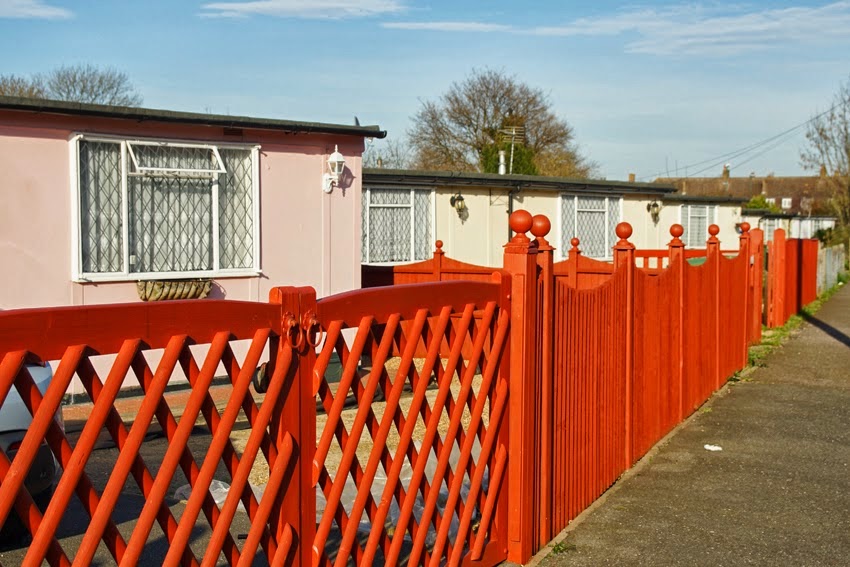Sunday, March 23, 2014
Catford, London
Far from ordinary
‘The glory of the ordinary’ was one reader’s comment on this blog and its subject matter, especially the parts of it that concern themselves with shacks, corrugated iron barns, battered factories, and other unregarded delights. But I didn’t always pay attention to this kind of architectural ordinariness – extraordinary buildings, from English cathedrals to Italian palazzi, once seemed more worthwhile, and years ago, when I lived not far from southeast London’s Excalibur prefab estate, I didn’t look at the place very closely, pausing only to be amused by the Arthurian street names (Ector Road, Pelinore Road) and to notice the similarities between the prefabs that lined these streets and the ones I remembered not far from where I lived as a child. There had always been prefabs around, ‘war prefabs’ as my parents and their friends called them, built en masse to relieve the housing shortage (and to give the suddenly underemployed aircraft industry something to do) after World War II.
Back in the 1960s, when I was a boy, the thing that my parents said about these prefabs were that they were meant to be temporary dwellings, with a life of ten years or so, and that the little houses had done well to last twice that time already. Now, 60 or more years after their construction, there are very few of these prefabs left: most have been demolished to make way for more modern housing, often at a higher density to take advantage of today’s high city land values.
So prefabs are no longer ordinary. The Excalibur Estate is now the only surviving prefab estate left, and is itself threatened with demolition. English Heritage have listed a handful of the prefabs (and the estate’s curious prefabricated church), but the council want to pull down the other 180 prefabs and replace them with a larger number of more modern dwellings. My feelings about this are mixed. On the one hand, London needs more good social housing and the prefabs would prove costly to preserve. On the other, the prefabs are a unique bit of social and architectural history. The residents, when polled, voted for demolition and redevelopment, by a narrow margin of 56 to 44 per cent.
The estate was built in 1945–6, and consists of prefabricated Uni-Seco bungalows, which have a timber frame supporting panels of asbestos cement. There are metal-framed windows and roofs with a very gentle pitch that look flat. The Uni-Seco was one of 13 different types of prefab built in Britain in the 1940s under the government’s Temporary Housing Programme, which eventually saw some 150,000 prefabs built to help relieve the housing shortage. More would have been built, but the prefabs (whether in wood, aluminium, concrete, or asbestos cement – there were examples of all these forms of construction) were actually quite costly to produce, so traditional, permanent, brick-built houses eventually prevailed.
Most residents liked their prefabs, not least because they came with modern features such as fully equipped bathrooms, indoor lavatories, and fitted kitchens with hot and cold water and something that most British houses lacked in 1948: a refrigerator. This was the kind of specification that many Brits could only dream of in the post-war period and the buildings, with their almost-flat roofs, white walls, and large windows, looked modern too. If they cared about such things, the original tenants might have reflected that at last their were getting a bit of the modern design that had been such a hit in Europe. But the generous gardens were probably just as important to them.
And there, for now, they stand, their chivalric street names (actually a continuation of a theme used to name streets in a neighbouring estate) evoking both post-war patriotism and 21st-century defiance. In this age of austerity, these far-from ordinary little buildings are worth a thought and, it seems to me, some admiration too.
- - -
With thanks to Caroline, of the excellent blog Caroline’s Miscellany, for the pictures. Her own piece on the Excalibur Estate is well worth reading.
There is an ongoing project to record the history of prefabs here.
The best books on prefabs are Greg Stevenson, Palaces for the People (Batsford, 2003) and Brenda Vale, Prefabs: A History of the UK Temporary Housing Programme (E & F N Spon, 1995)
Subscribe to:
Post Comments (Atom)





2 comments:
There are some further blog posts at http://diamondgeezer.blogspot.co.uk/2014/03/prefab-museum.html and http://www.ianvisits.co.uk/blog/2014/03/24/visit-the-prefab-museum-while-you-still-can/
very interesting thanks Philip! we had a few repurposed prefabs as classrooms at my school in the 80's - they may have been 'modern' but they didn't keep any heat in whatsoever
Post a Comment